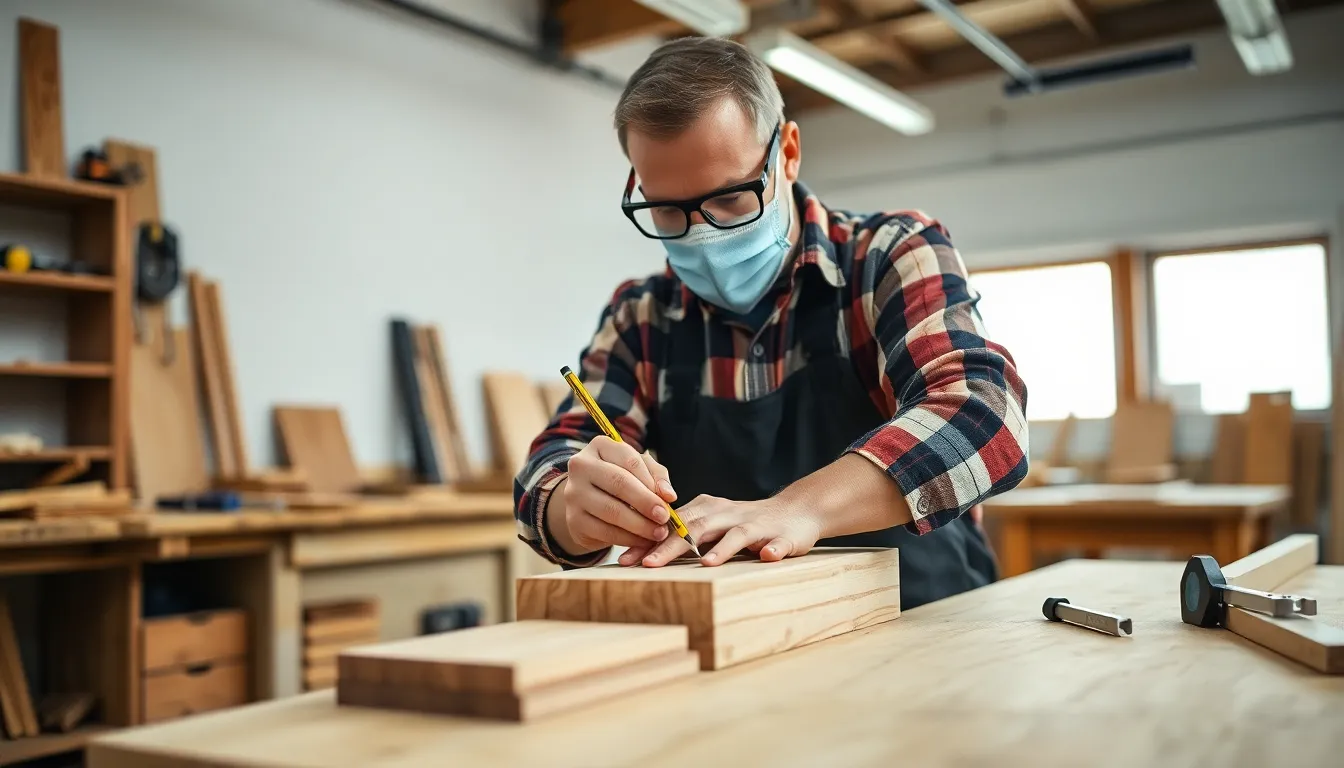Woodworking can feel like a magical dance between man and wood, where creativity meets craftsmanship. But let’s face it—without the right tips, that dance can quickly turn into a lumbering fiasco. Whether you’re a seasoned pro or just starting out, everyone can benefit from a few clever tricks to elevate their game.
Woodworking Tips
Starting woodworking requires understanding the tools and practicing safety. These tips aim to enhance skills and ensure a positive experience.
Understanding the Tools
Familiarity with essential tools forms the foundation for successful woodworking. A tape measure remains crucial for accuracy, helping to prevent costly mistakes. Additionally, a circular saw offers versatility for different cuts, while a chisel allows for finer detailing. Keeping hand tools like hammers and screwdrivers close at hand simplifies various tasks. Exploring different types of wood helps beginners choose suitable materials for their projects. Investing in quality tools often leads to better results and more satisfaction.
Safety Precautions
Prioritizing safety ensures a secure woodworking environment. Wearing safety goggles protects eyes from flying debris during cutting. Hearing protection is necessary when using loud machinery. Additionally, maintaining a clean workspace reduces the risk of accidents. Knowing how to properly handle tools prevents injuries; always keep fingers clear of blades and chisels. Following manufacturers’ instructions and guidelines furthers safety by using tools correctly. All these precautions contribute to a safer and more enjoyable woodworking experience.
Techniques for Better Woodworking

Techniques greatly enhance woodworking skills. They focus on precision and craftsmanship, ensuring projects turn out as envisioned.
Measuring and Marking Accurately
Accurate measurements form the foundation of successful woodworking projects. Use a reliable tape measure for precise dimensions. Marking with a sharp pencil ensures visibility and accuracy. Always double-check measurements before cutting to avoid mistakes. Align your markings with the grain of the wood to ensure clean cuts. Using specialized tools like a square or marking gauge enhances precision. Additionally, employing a straight edge aids in creating straight lines, reducing the chances of errors.
Mastering Joinery Techniques
Mastering joinery techniques significantly influences the strength and appearance of projects. Different types of joints offer various benefits. Mortise and tenon joints provide robust connections for structural applications. Dovetail joints work well for drawer construction, showcasing craftsmanship. Practice layout techniques to ensure perfect fitment. Understanding the nuances of each joint type leads to better, more durable results. Furthermore, exploring both traditional and modern joinery methods broadens skill sets and enhances versatility in projects.
Choosing the Right Wood
Selecting the appropriate wood type influences both the functionality and aesthetics of a project. Understanding various wood characteristics can guide choices effectively.
Types of Wood and Their Uses
Hardwoods, such as oak and maple, provide durability and a fine finish, making them suitable for furniture and cabinetry. Softwoods, including pine and cedar, are lighter and easier to work with, ideal for building frames or outdoor structures. Exotic woods like teak and mahogany offer unique looks for specialty items but often come with higher costs. Each type serves specific purposes, so selecting wood based on project requirements enhances both quality and longevity.
Sustainability in Wood Selection
Sustainable wood choices positively impact the environment. Sourcing wood from certified providers ensures responsible harvesting practices. Reclaimed wood provides a unique character and reduces waste. Additionally, using bamboo, a rapidly renewable resource, offers an eco-friendly alternative for various projects. Prioritizing sustainability not only preserves forests but also contributes to a healthier planet.
Finishing Touches in Woodworking
Finishing touches elevate woodworking projects, enhancing both appearance and durability. Carefully executed steps yield impressive results.
Sanding and Staining
Sanding smooths surfaces, preparing the wood for the next stage. Use fine-grit sandpaper for achieving a polished finish. Removing dust between sandings ensures a flawless look. Stains enhance the natural beauty of wood, adding color depth. Select stains that complement the wood type, considering oak accepts dark stains beautifully. Apply with a clean cloth or brush, focusing on even coverage. Allow ample drying time before applying additional coats to avoid streaks.
Varnishing and Sealing
Varnishing protects wood surfaces against wear and moisture. Start by choosing a suitable varnish type, like oil-based or water-based. Oil-based varnishes offer durability, while water-based options dry faster and have low odor. Apply with a brush or spray for an even coat. Sealing acts as a barrier against damage, preserving the wood’s integrity. Use sealers designed for woodworking, ensuring compatibility with previous finishes. Multiple thin coats yield better protection than a single thick layer. Allow adequate drying time between applications for optimal results.
Conclusion
Woodworking is a fulfilling journey that combines skill and creativity. By applying the tips shared in this article, woodworkers can significantly improve their craft. Understanding tools and prioritizing safety are foundational steps that pave the way for success.
Mastering techniques like precise measurements and joinery will enhance not only the quality of projects but also the satisfaction derived from them. Choosing the right wood and finishing touches further elevates the final outcome.
With patience and practice, anyone can transform raw materials into beautiful creations. Embracing these insights ensures a rewarding woodworking experience, whether for personal enjoyment or professional growth.

